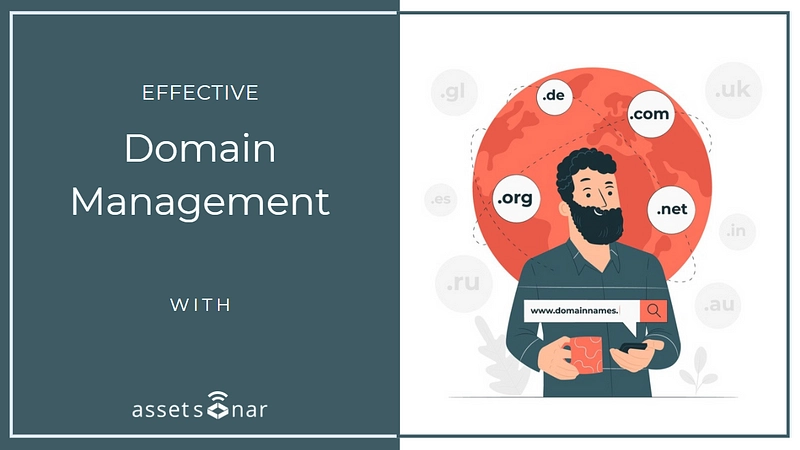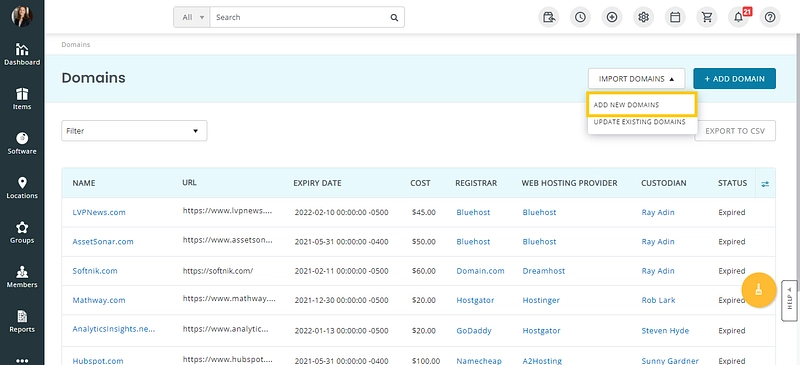Our new Domain management module keeps an exhaustive account of details associated with your company’s internet assets such as website domains. Keep tabs on the payment schedule, and expiry and renewal dates of your domain assets. Monitor domain utilization patterns and adjust future renewal cost and frequency as needed with AssetSonar.
Since domains help define your brand promise and improve your search optimization and digital marketing efforts, they are key assets to your organization, and their costs must be monitored effectively. AssetSonar helps you do just that!
Contents
- Creating a Domain
- Importing multiple Domains
2.1. Adding Domains
2.2. Mass updating Domains - Viewing, customizing, and filtering Domain Listings
- Managing Domain payments
- Domain states
- Custom fields in Domains
- Export Domain data
- Alerts for Domain management
- Dashboard KPIs
9.1. Active vs Expired Domains
9.2. Total cost of Domains - Domain management reports
1. Creating a Domain
Before you can manage individual domains, you need to first add them to your AssetSonar account. You can access the Domain management module from More → Domains on the dashboard.
This leads you to the Domain Listings page. You can see that there are no Domains added to the account yet. Click on the ‘Add Domain’ button, configure details, and hit ‘Done’ to create a Domain as shown.
AssetSonar gives you the ability to add the following details pertaining to a Domain.
- Name: The title of the Domain e.g. AssetSonar.com.
- Web Hosting Provider: The name of the Internet hosting service that hosts your website Domain.
- URL: The link address of the Domain e.g. https://ezo.io/assetsonar/.
- Registrar: Name of the registrar that sold you the business Domain name e.g. GoDaddy.
- IP Address: The numerical address of the Domain.
- Domain Cost: The dollar amount you paid to purchase the Domain.
- Custodian: The employee responsible for the management of the Domain.
- Renewal Frequency: The period after which the renewal fee of a Domain must be paid. It can be monthly or annual.
- Registration Date: The date when the Registrar sold you the Domain.
- Expiry Date: The date when the Domain expires.
- Privacy Enabled (Yes/No): The option to enable visibility of a Domain to users other than the Custodian.
Once you have created a Domain, you can view it on the Domain Details page as shown.
You can take the following actions on the Domain Details page:
- Edit the existing Domain
- Deactivate an Active Domain (or Activate an Inactive Domain)
- Add a new Domain
- Add payment to the existing Domain
Please note that:
- You can only edit the following Domain fields i.e. Registration and Expiry Dates, Renewal Frequency, and Renewal Cost.
- A Domain can only be deactivated before its expiration date has reached.
- You can permanently delete a Domain only after it has expired.
2. Importing multiple Domains
With the AssetSonar import wizard, you can add Domain data en masse using the CSV imports.
2.1. Adding Domains
To add multiple Domains, go to Import Domains → Add New Domains from the Domain Listings page.
Now, prepare an Excel sheet containing the following information for your Domains.
- Name (mandatory)
- Web Hosting Provider
- URL
- Registrar
- IP Address
- Domain Cost
- Custodian Email
- Privacy Enabled (Yes/No)
- Registration Date
- Expiry Date
- Renewal Cost
- Renewal Frequency
It should look like this:
Note: You may also add data for any custom fields that are associated with the Domain module in AssetSonar.
Alternatively, you can click the highlighted option to download a sample file for yourself.
Next, upload the Excel sheet (CSV) by clicking on Choose File → Upload and Proceed.
Map the columns as shown.
Preview your import data and click ‘Import’ when you’re ready!
This shall add the domains in bulk to AssetSonar.
Note: By clicking on ‘Save Template’, you can avoid mapping of columns every time you carry out an Excel import in the future.
2.2. Mass updating Domains
Domains can be mass updated just as you would add them via CSV imports. For this, follow the pathway Import Domains → Update Existing Domains from the Domain Listings page.
Use the same import steps as mentioned in 2.1.
3. Viewing, customizing, and filtering Domain Listings
The Domain Listings page catalogs the entire inventory of Domain assets once you’ve added them to your AssetSonar account.
You can add or delete columns from the list view by clicking on the ‘Edit’ icon, selecting the relevant columns, and clicking on the ‘Save this view’ button.
The Domains can also be filtered by their Status, Cost, Web Hosting Providers, Expiry Date, or Custodians.
Let’s say if you want to see which Domains are the responsibility of a certain employee, Ray Adin in this case, you can apply the filter by that Custodian.
Go to the Filter dropdown → Custodian → Custodian Name (Ray Adin) → Apply to update the list view per your requirement. You can see that the results have now been filtered by Ray Adin as the Custodian.
4. Managing Domain payments
You can also manage costs associated with multiple Domains by adding purchase and renewal payments to each Domain.
To do so, click on the ‘Add Payment’ button on the Domain Details page.
Specify the amount and the payment reason and hit ‘Add Payment’.
Once you’ve added all the payments associated with a Domain, you can view them in a payment schedule on the Domain Details page.
Note: AssetSonar applies an automatic renewal policy to renewal payments. Therefore, whenever a Renewal Frequency period i.e. a month or a year is over, renewal payment is automatically added to the payment schedule.
You can also void a certain payment if it no longer applies to a Domain by clicking on the ‘Void’ button next to a payment.
Type the reason and click on ‘Void’ to complete the action. The payment has now been voided and doesn’t count to the total Domain cost as shown below.
5. Domain states
Each Domain has 4 states. These are as follows:
- Active: A Domain is in the Active state if it falls anywhere between its Registration and Expiry Date, except when it has not been deactivated.
- Inactive: A Domain that has been deactivated by the Administrator is an Inactive Domain.
- Expired: A Domain enters the Expired state after its Expiry Date has reached.
6. Custom fields in Domains
Suppose as an IT Administrator, you wish to add and track details regarding Domains that are not added in AssetSonar by default, for instance, the Domain Purpose i.e. whether the Domain has been purchased for production or staging reasons.
You can track such data values by creating custom fields for the Domain module. To do so, go to More → Custom Fields → Domains → Add Custom Field.
This pops open an overlay. Here, you can configure details for the relevant custom field. Click ‘Add’ when you’re done.
You can also choose to make the custom field a mandatory option for users to fill.
Apart from the Dropdown type, you can also create custom fields for these types:
- Number
- Date field (alert)
- Paragraph text
- Single line text
- Boolean
7. Export Domain data
If you want to keep the back up of your Domain data or transfer it into another third-party application, you can export the information directly from the Domain Listings page.
Click on ‘Export to CSV’.
This shall download your Domain data as a CSV file that you can later import to the third-party application.
8. Alerts for Domains
Let’s say, you have a Domain expiring in a certain number of days and you’re not aware of it. You may fail to re-register for it and your website may crash putting your business operations to a halt.
You can avoid running into this scenario by setting an alert for when a Domain is about to expire.
For this purpose, go to More → Alerts → My Alerts → Domains, select the option ‘Domain expiring in _____ days’, and hit ‘Save Settings’.
You’ll now receive an alert 10 days before any Domain is about to expire.
9. Dashboard KPIs
AssetSonar also allows you to customize your dashboard view to display KPIs and graphs related to Domain assets. There are primarily two kinds of metrics you can add to your dashboard.
9.1. Active vs Expired Domains
This graph shows a visual representation of how many Active and Expired Domains are within your AssetSonar account. It reveals the total number of Expired Domains so you can take action on them as needed.
To add this graph, go to Dashboard → Edit → Add/Edit Widgets → Dashboard Settings → Graphs, select ‘Number of Active vs Expired Domains’, and hit ‘Done’.
9.2. Total cost of all Domains
This metric displays the total dollar amount you spend on your Domain assets. In order to add this to the dashboard, go to Dashboard → Edit → Add/Edit Widgets → Dashboard Settings → KPI Metrics → Total Cost of All Domains → Done.
Once updated, this is how the dashboard shows you details of the total Domain cost you have incurred.
10. Domain management reports
AssetSonar gives you further insights into your Domain management landscape by enabling you to run detailed reports on Domain payment history and the Expiry status of your Domains.
To run any of these reports, follow the pathway: More → Reports → Domain management, select your preferred report, and click on ‘View Report’.
In this case, we’ve created a report for Domain payment history. This is how it will look like:
You can also apply different filters to Domain management reports based on your needs and view specific search results.
Read more: Implement Effective IT Asset Duplicate Management With AssetSonar
About AssetSonar
AssetSonar is the leading IT asset management software used by IT-intensive organizations and businesses all over the globe. Sign up today for a free 15-day trial.
For more assistance, drop us an email at support@ezo.io. You can also visit our blog for detailed support posts.
Join the Conversation: Twitter | Facebook



































